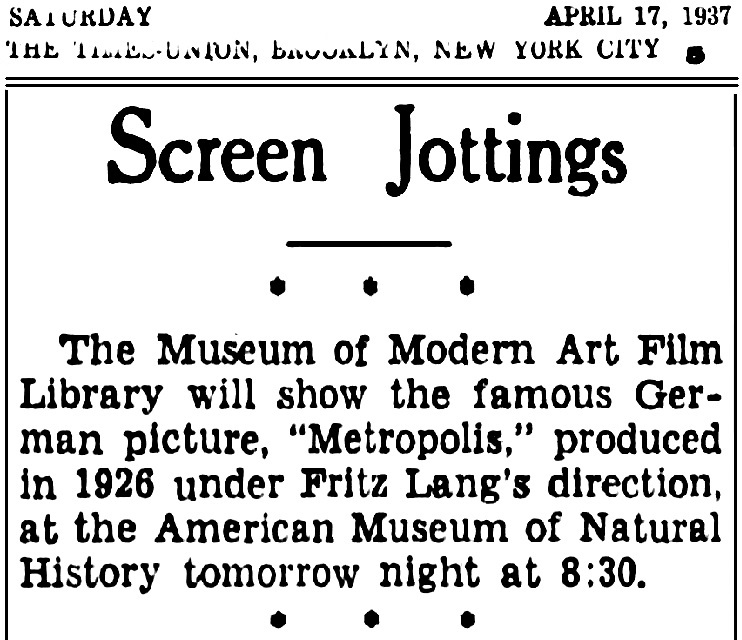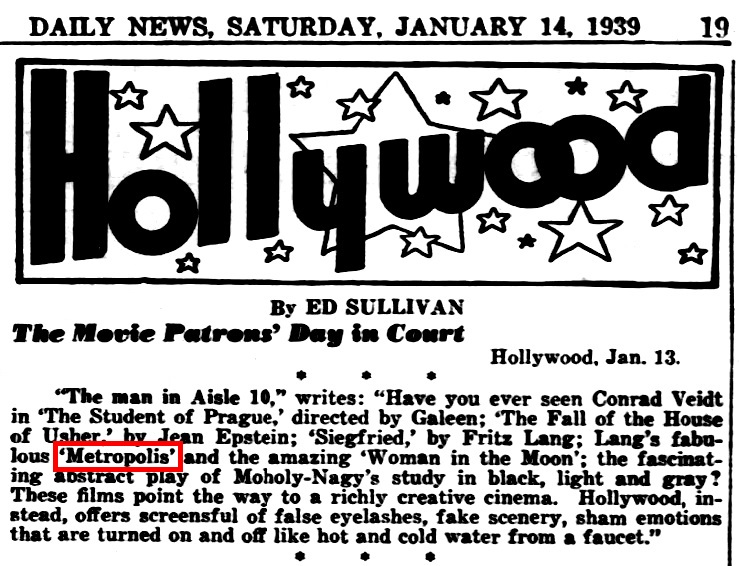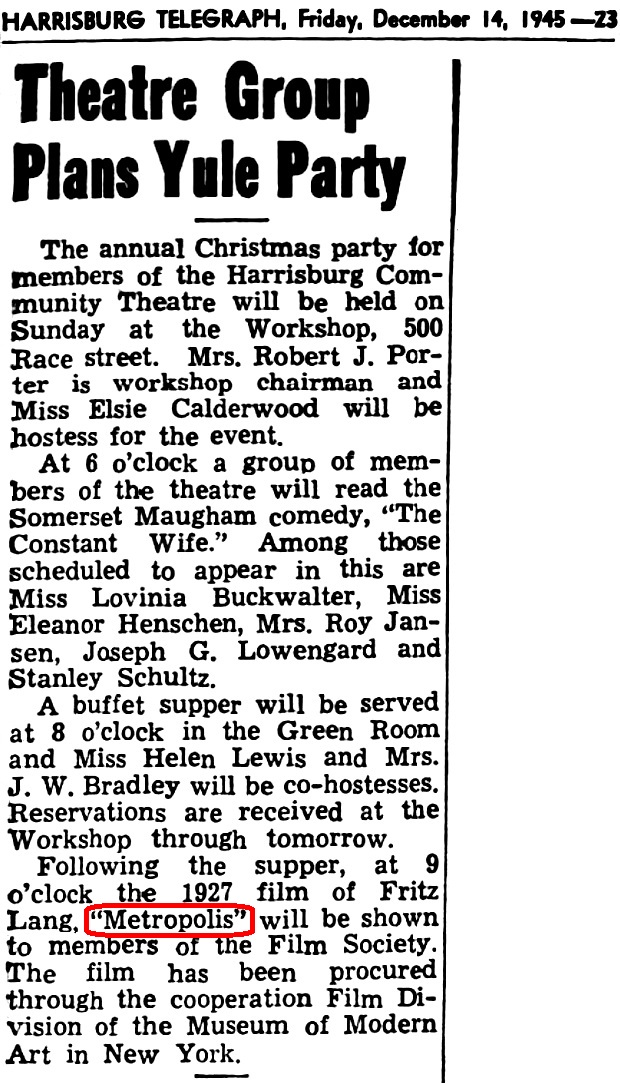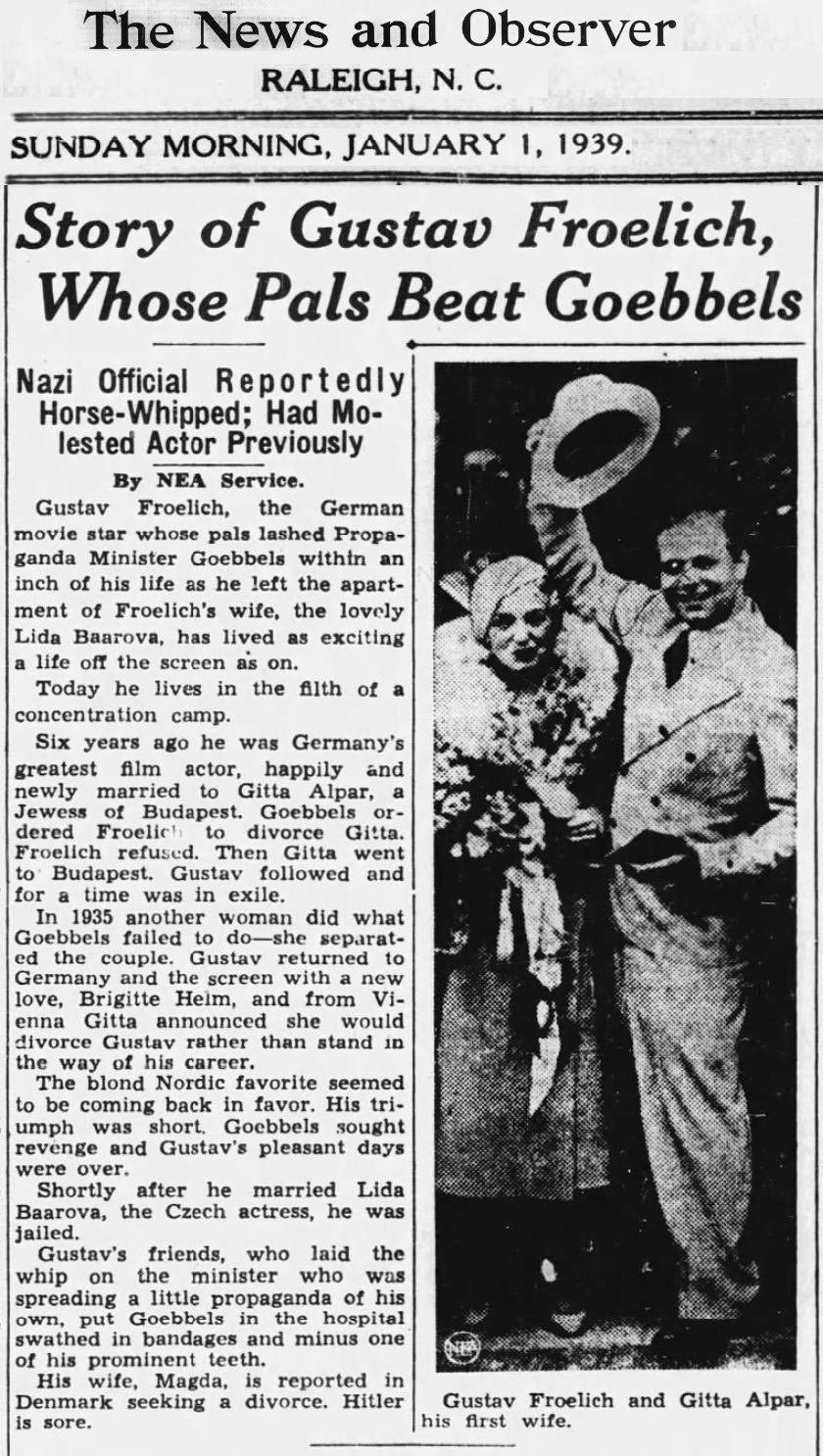| Return home |  |
Return to previous page |
August 1936: Iris Barry
|
In the summer of 1936, Iris Barry, the founder of the
film archive of the Museum of Modern Art
(MoMA), came to Berlin during the Olympic
Games to purchase copies of German film
classics here for the museum’s film collection.
In addition to other films, she received a copy
of METROPOLIS from Ufa. As a comparison
with the five reels recopied in Wiesbaden
shows, this copy was derived from the original
negative stored by Ufa. The nitrate copy given
to MoMA no longer exists, but there is a dupe
negative made from it in 1937 in New York;
this dupe [would] be restored once again in
1947, using film clips from the then still extant
earlier copy after the dupe was damaged or
had become partially unusable for other
reasons. Since 1986, this dupe negative
has been in possession of the Munich Filmmuseum.
As opposed to the 2,589 meter [8,494', or 94 min. at 24fps]
length (without silent-film captions) measured
by Ufa in 1934, additional footage is now
missing: The nine reels of dupe negative are
only 2,532 meters long [8,307', or just over 92 min. at 24fps] (including silent-film
captions).
|
The above passage led me down a wrong path on the wrong road in the wrong village at the wrong time of night.
The facts are there, sort of, but they’re jumbled and confused and distorted.
Let us unravel this tiny bit by tiny bit.
Iris Barry. All I know about this gal is that she rescued movie history.
Were it not for her, we would have hardly any of our movie heritage.
Were it not for this gal, repertory cinema would never have come into existence.
Think of almost any early movie that you enjoy.
Chances are that Iris is the one who prevented it from going into the trash bin.
Iris Barry received a lavender (low-contrast fine-grain).
The nitrate lavender that Iris took back to MoMA with her was directly off of the negative held by Ufa,
or, rather, what little was left of the negative held by Ufa.
It was not until recently that researchers discovered something.
The negative that was used to make MoMA’s print was not merely abridged, it was
inauthentic.
Some of it was from spares (alternative takes) that were used to replace damaged sections.
As we shall witness first-hand below,
some damaged sections of the Ufa negative were filled in with dupes of the export edition.
It would not surprise me to learn that some parts were replaced with dupes of the German edition as well.
All right.
This is slowly beginning to come into focus.
Claim: “...she received a copy of METROPOLIS from Ufa.... The nitrate copy given to MoMA no longer exists....”
Correction: Ufa sold a lavender to MoMA in August 1936.
Claim: “The nitrate copy given to MoMA no longer exists, but there is a dupe negative made from it in 1937 in New York....”
Correction: Sometime in 1937, MoMA used that lavender to run off a copy negative, not a dupe negative.
MoMA needed to generate a copy negative in order to run off prints for exhibition and circulation.
Claim: “As early as 1938,
the MoMA version was duplicated for the
National Film Library in London....”
Correction: Not exactly. MoMA ran off a second copy negative from its lavender
and shipped that second copy negative to the British Film Institute’s newly established National Film Library.
There was NO NEED AT ALL to duplicate MoMA’s copy.
The second copy negative, being derived from the same lavender, would have been identical in every way to MoMA’s copy negative,
without further generational loss.
As we shall learn below, the National Film Library did not put this copy negative to use until at least 1939,
when it generated a fine grain and presumably ran off a screening print.
Correction: The copy negative (not dupe negative) was not “restored once again”;
it was repaired!
It could not have been “restored once again” because it had not been restored previously.
MoMA never restored the film and never needed to.
In 1947, some pieces of the copy negative had gotten damaged or had rotted through,
and so the 1936 lavender was sent back to the lab to have a new copy negative made
only of the sections that needed replacing in the copy negative.
There was no further generational loss.
My wild guess is that a single reel was damaged and that a new copy negative was made of that single reel.
Do you know how many months it took me to make sense out of previous publications?
Sheesh!
It had been bothering me that the 16mm prints offered by MoMA and the BFI had the left side (and top) missing.
It had been bothering me that the 35mm commercial release prints all had the left side missing.
Why?
Why were they misprinted?
Could it have been that the lavender that Ufa sold to MoMA was missing the left side?
No!
I now have proof, and you do too, that the entire image was on the lavender.
(We’ll get to the proof later. Hang tight.)
So, why did MoMA set the titles for an Academy crop,
and why did MoMA’s 16mm prints lop off the left side and the top?
That is the puzzle.
MoMA was meticulous about retaining the entire image, even on 16mm prints,
and so why Metropolis was misprinted is a mystery to me.
It could not have been an accident.
Had it been an accident, then the titles would all have been off-center to the left.
Instead, they are off-center to the right, and appear centered only if projected through a sound aperture.
I am mystified.
This may have been the first public screening of the MoMA print:
We learned above that it was in 1938 that MoMA ran off a second copy negative for the BFI’s National Film Library in London.
We now learn why:
Ed Sullivan (yes) asked readers to explain what was right about European films
and what was wrong with Hollywood films.
Among the responses was one that was either a decade-old reminiscence
or a reaction to a very recent discovery:
The war was now on, but the US was still neutral.
Besides, Fritz was now one of us.
The MoMA print appeared in San Francisco.
This may have been the second and final screening for a few years yet:
Then the US entered the war, and even though MoMA kept Metropolis available,
it appears that nobody, but nobody, had the slightest curiosity about looking at it.
Once the war ended, though, the requests began again, right away,
and MoMA obliged:
Events in the UK paralleled those here,
and the BFI’s National Film Library began to receive requests:
Duh. It was not until a full week after beginning this essay that my memory fired back up.
I asked myself: “Hey, didn’t I work on a book on Metropolis?”
I went to my shelf, and yup, there it was, the book I had typeset back in 2000:
Michael Minden and Holger Bachmann, eds.,
Fritz Lang’s Metropolis: Cinematic Visions of Technology and Fear
(Rochester, NY: Camden House, 2000).
On page 116, if I understand it correctly, Enno Patalas reveals
that the material that Iris Barry received from Ufa was indeed a lavender.
(As I flip through the pages now, for the first time in more than two decades,
I see that Holger Bachmann debunked the claims that it was Metropolis that bankrupted Ufa.
See pp. 33, 43–44 .
Ufa was already in trouble, and Metropolis was the scapegoat.)
I read the book as I was typesetting it.
I remember making a couple of corrections.
The outsourced copy-editor had changed Publix to Public, for instance, and so I explained why I changed it back (p. 91).
No longer can I remember the other fixes I made, but there were a few, definitely.
As I was reading it while I was typesetting it from its original Word files, I was deeply frustrated.
The two things I most wanted to know were nowhere mentioned in the book; they were not even hinted at.
First: Where did the PBS edition come from, and where did it go, and how can I see it again?
Second: Can anybody explain the Janus edition?
The reason the book entirely slipped my mind was simply because it offered not so much as a clue about those two riddles —
at least, not a clue I could recognize as such.
Also, I was astounded by Enno Patalas’s anecdote on pages 117–118:
|
In 1983 Joachim Bärenz accompanied the working copy of Metropolis
for the first time in the Munich Film Museum on the piano —
according to the surviving cut of the film, which had also served us as a
basis for producing the montage of the extant bits and pieces, but arranged
according to the sequence of our newly assembled version. Up
to that time, it was not customary to provide musical accompaniment
for films screened in the Film Museum. In 1977, when designing the
new black cinema — one with no reflective surface but the sharply delineated
white rectangle of the screen, so that nothing could be seen but
the film — I insisted on acoustics in which the silence would complement
a silent film instead of seeming awkward as it had been in the case
in the old, provisional hall. Only when the frequent discoveries of
scores and the activities of people such as Joachim Bärenz made clear
that music often was an important part of the original shape of a film
did we make an effort to screen silent films with music, if possible with
the original music; we let Rudolf Augstein and Gunther Sachs donate a
new Bösendorfer for us and nurtured Aljoscha Zimmermann as house
pianist, arranger, and composer. Since 1989, he has also accompanied
Metropolis in the Film Museum with his arrangement of the Huppertz
score.
|
Now you know why I can no longer work in cinema or theatre. This is a perfect example. I am about the most mellow,
Also, there is seldom anything sacred about the “original” score.
Each cinema compiled its own custom scores, based on a repertoire of several hundred stock tunes in its collection,
music that the players could perform almost by memory.
The “original” scores were mostly just suggestions that cinemas were free to alter, modify, or entirely ignore.
There was only a handful of movies for which the filmmakers designated a required score,
but that was true only for the roadshow engagements.
Griffith did that sometimes, and so did a few others.
That was very rare.
Michael Minden stands up for Enno Patalas. He just wrote to me:
|
I should defend Patalas, who isn’t saying silent film was not accompanied by music,
but simply it had not until then (1985 not 1983) been the practice of his institution, the Munich Film Museum,
to use music, presumably a visual purism that, as he explains, they realised was not appropriate.
|
Getting back to Enno Patalas, he has information that contradicts the Murnau Foundation:
|
When... Iris Barry... asked Ufa for a copy of the second German version of the
film, this version had a length of 2,250 metres, to which one must add
three hundred metres of intertitles (the negative only had flash titles)....
|
You don’t know what a flash title is. Titles (dialogue or exposition) were generally held on long enough to be read three times by literate people, or about once through by recent immigrants and uneducated people and small children just learning their ABC’s. When exporting the films, the distributors cut the titles to one frame each, mostly to save on shipping costs and taxes, partly to save on raw stock. Each foreign distributor would then translate those titles into the local language, film them, and splice them in. Patalas kindly tells us that, altogether, the Metropolis titles totalled about 300m (984'=11 minutes).
The Murnau Foundation claims that, in 1934, that exact same edition was 2,589m (94 minutes) with flash titles.
Patalas writes that in 1936 Barry received a 2,250m edition (82 minutes) with flash titles.
The Murnau Foundation further claims that MoMA’s 1947 dupe negative was 2,532m (92 minutes) with titles.
Wikipedia disputes the 2,250m figure, preferring 2,230m (81 minutes).
I tend to trust Patalas more than Wikipedia, and so, for the sake of argument, let’s take Patalas at his word
that the lavender that Iris received in 1936 was 2,250m, and, further, that once the MoMA crew spliced the titles in for the new copy negative,
it was 2,532m, which comes to 282m of titles rather than 300m (925' rather than 984', or 10min17sec rather than 10min56sec),
and that leads me to think that 300m was a rounded figure.
Wikipedia also adds some information that is initially confusing:
|
Later, after demands for more cuts by Nazi censors,
UFA distributed a still shorter version of the film (2,530 metres, 91 minutes) in 1936,
and an English version of this cut was archived in the Museum of Modern Art (MoMA) film library in the 1930s.
It was this version which was the basis of all versions of Metropolis until the recent restorations.
|
The Wikipedia numbers are rounded.
When MoMA printed in the titles, the result was 2,532m,
which is effectively the same as the 2,530m that Ufa had when the German titles were included.
We are here talking about exactly the same version,
identical except for language and generation.
The claim of Nazi censorship in 1936 is also made by Louis Geisler in
“The Miseries and Splendors of Metropolis,”
Festival d’Aix-en-Provence, 4–24 Juillet 2023.
It was not true that “this [MoMA] version which was the basis of all versions of Metropolis until the recent restorations.”
As we shall learn shortly, the Associated British and Janus editions derived from a different source,
though they were admittedly not restorations, but merely reissues.







